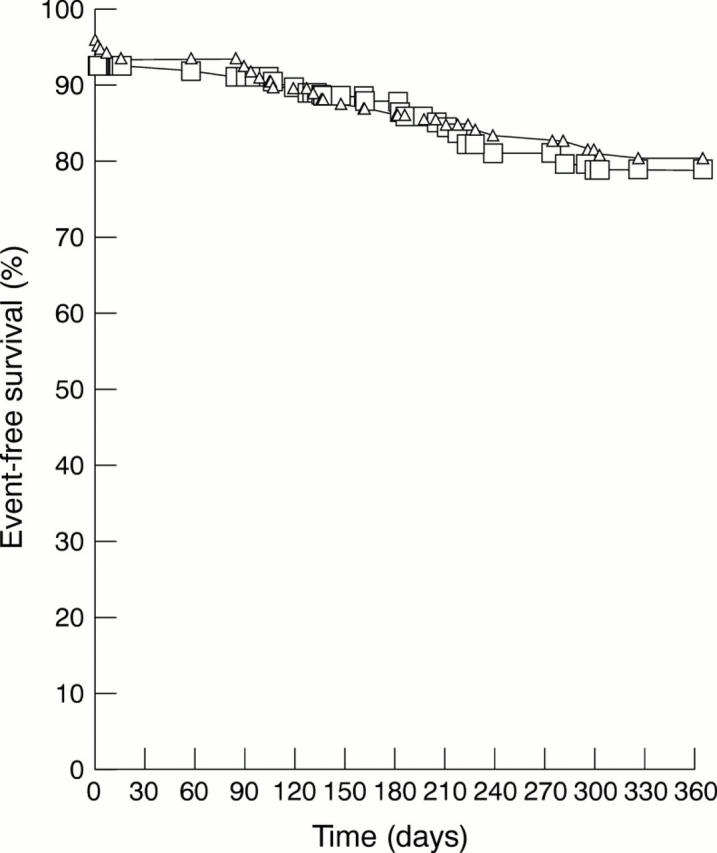Abstract
AIM—To compare the immediate and late outcomes of patients treated by a policy of routine stent implantation with routine balloon angioplasty and the use of stents only when an ideal result has not been obtained. METHODS—A nine centre, multinational, randomised study of 300 patients with coronary artery disease thought suitable for treatment of a single lesion by balloon angioplasty or stent implantation. Only new lesions in patients who had not undergone previous bypass surgery were included, and totally occluded vessels were excluded. RESULTS—The initial procedure was considered successful in 96% of patients. There was more complete angiographic restoration of luminal diameter in patients treated by elective stent (minimum lumen diameter (MLD) 2.68 mm for stent v 2.27 mm for balloon; p < 0.007), but analysis of the subgroup of balloon angioplasty patients who crossed over to stenting showed that they achieved similar results to the elective stent group. Late luminal loss was greater in stented patients than in those undergoing balloon angioplasty only, and by six months the angiographic benefit of stenting had disappeared (MLD 1.90 mm for stent group v 2.00 mm for balloon angioplasty). Angiographic and clinical results in the balloon angioplasty group were assisted by the high crossover rate (30.1%). Both groups had similar symptom relief, with 58.9% of patients improving by two or more angina grades. The need for further revascularisation was also similar in the two groups at one year (18.2% in the stented group v 17.1% in the balloon angioplasty group). Haemorrhagic complications at the local arterial entry site were more common than expected and were distributed equally between the patients receiving full anticoagulation and those receiving antiplatelet treatment only. The results of both Wiktor stent placement and balloon angioplasty were similar to the findings in the stent group in previous randomised studies (Benestent II, STRESS). CONCLUSIONS—Provisional stenting appears to offer the same longer term outcome as elective stenting in this selected group of patients. Improvement in the results of conventional balloon angioplasty in the past 10 years means that a policy of obtaining an ideal result without the use of stents appears to be practicable in many of these patients, with consequent cost savings. Keywords: stent; balloon angioplasty; coronary angioplasty
Full Text
The Full Text of this article is available as a PDF (145.4 KB).
Figure 1 .

Kaplan-Meier curve curve showing event-free survival (%) from death, myocardial infarction, or a repeat revascularisation procedure. ▫, stent; ▵, POBA.
Selected References
These references are in PubMed. This may not be the complete list of references from this article.
- BLACKBURN H., KEYS A., SIMONSON E., RAUTAHARJU P., PUNSAR S. The electrocardiogram in population studies. A classification system. Circulation. 1960 Jun;21:1160–1175. doi: 10.1161/01.cir.21.6.1160. [DOI] [PubMed] [Google Scholar]
- Buchwald A., Unterberg C., Werner G., Voth E., Kreuzer H., Wiegand V. Initial clinical results with the Wiktor stent: a new balloon-expandable coronary stent. Clin Cardiol. 1991 May;14(5):374–379. doi: 10.1002/clc.4960140504. [DOI] [PubMed] [Google Scholar]
- Colombo A., Hall P., Nakamura S., Almagor Y., Maiello L., Martini G., Gaglione A., Goldberg S. L., Tobis J. M. Intracoronary stenting without anticoagulation accomplished with intravascular ultrasound guidance. Circulation. 1995 Mar 15;91(6):1676–1688. doi: 10.1161/01.cir.91.6.1676. [DOI] [PubMed] [Google Scholar]
- Fischman D. L., Leon M. B., Baim D. S., Schatz R. A., Savage M. P., Penn I., Detre K., Veltri L., Ricci D., Nobuyoshi M. A randomized comparison of coronary-stent placement and balloon angioplasty in the treatment of coronary artery disease. Stent Restenosis Study Investigators. N Engl J Med. 1994 Aug 25;331(8):496–501. doi: 10.1056/NEJM199408253310802. [DOI] [PubMed] [Google Scholar]
- Grüntzig A. R., Senning A., Siegenthaler W. E. Nonoperative dilatation of coronary-artery stenosis: percutaneous transluminal coronary angioplasty. N Engl J Med. 1979 Jul 12;301(2):61–68. doi: 10.1056/NEJM197907123010201. [DOI] [PubMed] [Google Scholar]
- Hall P., Nakamura S., Maiello L., Itoh A., Blengino S., Martini G., Ferraro M., Colombo A. A randomized comparison of combined ticlopidine and aspirin therapy versus aspirin therapy alone after successful intravascular ultrasound-guided stent implantation. Circulation. 1996 Jan 15;93(2):215–222. doi: 10.1161/01.cir.93.2.215. [DOI] [PubMed] [Google Scholar]
- Kuntz R. E., Gibson C. M., Nobuyoshi M., Baim D. S. Generalized model of restenosis after conventional balloon angioplasty, stenting and directional atherectomy. J Am Coll Cardiol. 1993 Jan;21(1):15–25. doi: 10.1016/0735-1097(93)90712-a. [DOI] [PubMed] [Google Scholar]
- Narins C. R., Holmes D. R., Jr, Topol E. J. A call for provisional stenting: the balloon is back! Circulation. 1998 Apr 7;97(13):1298–1305. doi: 10.1161/01.cir.97.13.1298. [DOI] [PubMed] [Google Scholar]
- Serruys P. W., de Jaegere P., Kiemeneij F., Macaya C., Rutsch W., Heyndrickx G., Emanuelsson H., Marco J., Legrand V., Materne P. A comparison of balloon-expandable-stent implantation with balloon angioplasty in patients with coronary artery disease. Benestent Study Group. N Engl J Med. 1994 Aug 25;331(8):489–495. doi: 10.1056/NEJM199408253310801. [DOI] [PubMed] [Google Scholar]
- Serruys P. W., van Hout B., Bonnier H., Legrand V., Garcia E., Macaya C., Sousa E., van der Giessen W., Colombo A., Seabra-Gomes R. Randomised comparison of implantation of heparin-coated stents with balloon angioplasty in selected patients with coronary artery disease (Benestent II) Lancet. 1998 Aug 29;352(9129):673–681. doi: 10.1016/s0140-6736(97)11128-x. [DOI] [PubMed] [Google Scholar]
- Sigwart U., Kaufmann U., Golf S., Urban P., Buchbinder N., Morin D., Essinger A., Kappenberger L. L'incidence et le traitement de la resténose coronarienne malgré l'implantation d'une endoprothèse. Schweiz Med Wochenschr. 1988 Nov 19;118(46):1715–1718. [PubMed] [Google Scholar]
- van der Zwet P. M., Reiber J. H. A new approach for the quantification of complex lesion morphology: the gradient field transform; basic principles and validation results. J Am Coll Cardiol. 1994 Jul;24(1):216–224. doi: 10.1016/0735-1097(94)90566-5. [DOI] [PubMed] [Google Scholar]


